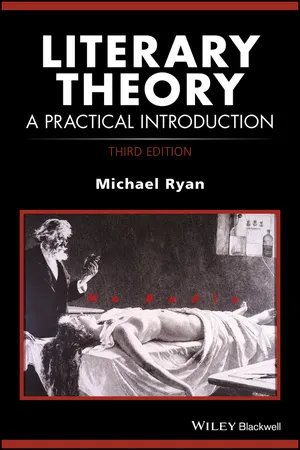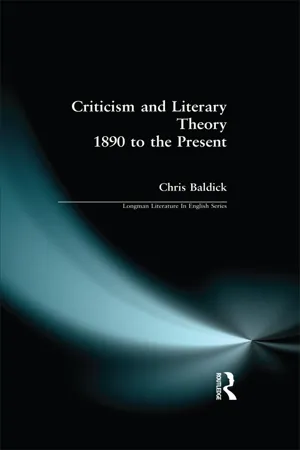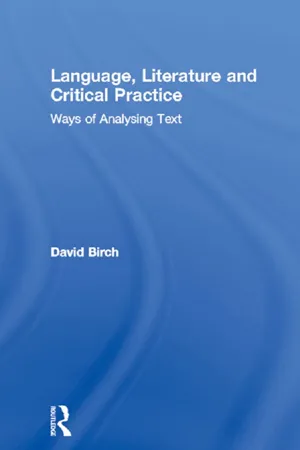Literature
Structuralism Literary Theory
Structuralism in literary theory focuses on analyzing literature by examining the underlying structures and systems that shape the text. It emphasizes the interconnectedness of elements within a literary work and seeks to uncover the underlying patterns and codes that govern its meaning. Structuralist literary theory often explores the relationship between language and culture, and how these factors influence the production and interpretation of literature.
Written by Perlego with AI-assistance
Related key terms
8 Key excerpts on "Structuralism Literary Theory"
- eBook - ePub
Critical Theory Today
A User-Friendly Guide
- Lois Tyson(Author)
- 2014(Publication Date)
- Routledge(Publisher)
For students of literature, structuralism has very important implications. After all, literature is a verbal art: it is composed of language. So its relation to the “master” structure, language, is very direct. In addition, structuralists believe that the structuring mechanisms of the human mind are the means by which we make sense out of chaos, and literature is a fundamental means by which human beings explain the world to themselves, that is, make sense out of chaos. So there seems to be a rather powerful parallel between literature as a field of study and structuralism as a method of analysis.Our discussion of structuralist approaches to literature will focus on the narrative dimension of literary texts because structuralist criticism deals mainly with narrative. This focus is not as narrow as it may seem at first glance, however, if we remember that narrative includes a long history and broad range of texts, from the simple myths and folk tales of the ancient oral tradition to the complex mélange of written forms found in the postmodern novel. In addition, most drama and a good deal of poetry, though not classified as narrative, nevertheless have a narrative dimension in that they tell a story of some sort. In any event, as we’ll see, narratives provide fertile ground for structuralist criticism because, despite their range of forms, narratives share certain structural features, such as plot, setting, and character.We must keep in mind, however, that structuralism does not attempt to interpret what individual texts mean or even whether or not a given text is good literature. Issues of interpretation and literary quality are in the domain of surface phenomena, the domain of parole. Structuralism seeks instead the langue of literary texts, the structure that allows texts to make meaning, often referred to as a grammar because it governs the rules by which fundamental literary elements are identified (for example, the hero, the damsel in distress, and the villain) and combined (for example, the hero tries to save the damsel in distress from the villain). In short, structuralism isn’t interested in what a text means, but in how a text means what it means. Thus, The Great Gatsby’s - eBook - ePub
Critical Theory Today
A User-Friendly Guide
- Lois Tyson(Author)
- 2023(Publication Date)
- Routledge(Publisher)
In terms of literary study, the same model of structuralist activity holds true. You are not engaged in structuralist activity if you describe the structure of a short story to interpret what the work means or evaluate whether or not it’s good literature. However, you are engaged in structuralist activity if you examine the structure of a large number of short stories to discover the underlying principles that govern their composition, for example, principles of narrative progression (the order in which plot events occur) or of characterization (the functions each character performs in relation to the narrative as a whole). You are also engaged in structuralist activity if you describe the structure of a single literary work to discover how its composition demonstrates the underlying principles of a given structural system.In other words, structuralists are not interested in individual buildings or individual literary works (or individual phenomena of any kind) except in terms of what those individual items can tell us about the structures that underlie and organize all items of that kind. For structuralism sees itself as a human science whose effort is to understand, in a systematic way, the fundamental structures that underlie all human experience and, therefore, all human behavior and production. For this reason, structuralism shouldn’t be thought of as a field of study. Rather, it’s a method of systematizing human experience that is used in many different fields of study: for example, linguistics, anthropology, sociology, psychology, and literary studies.For structuralism, the world as we know it consists of two fundamental levels – one visible, the other invisible. The visible world consists of what might be called surface phenomena: all the countless objects, activities, and behaviors we observe, participate in, and interact with every day. The invisible world consists of the structures that underlie and organize all of these phenomena so that we can make sense of them. For example, the English language consists of over a million words, each of which can be pronounced in any number of different ways by different speakers, resulting in millions of different utterances of individual words. How is it possible that native speakers of English master enough of this overwhelming collection of linguistic items to communicate effectively with one another at a rather advanced level of sophistication and at a rather early age? - eBook - ePub
Literary Theory
A Practical Introduction
- Michael Ryan(Author)
- 2017(Publication Date)
- Wiley-Blackwell(Publisher)
CHAPTER 2 Structuralism, Linguistics, NarratologyAn Introduction to Structuralism
To grasp what is meant by structure in literature, think of a body. Its skeleton is crucial to how it works, but the skeleton is invisible. In a similar manner, a work of literature has a structure that never appears as such but that allows the work to make sense or to function as a work of literature. Another way of thinking about structure is to picture a sports match like tennis or golf. If you did not know the rules of the game – something that happens to anyone who changes countries and encounters new games for the first time – you would not know how to make sense of two men hitting a ball back and forth. And you might not know the point of hitting a small ball down a long field toward a flag atop a pole on something called a “green.” The actions in each game could be senseless, but invisible rules lend them structure. They come to have meaning because of the conventions or agreements that guide play.Structure in literature can be described in several ways. Each work of literature has a structure unique unto itself. That structure accounts for how its various elements are organized and arranged in relation to one another. A fictional or dramatic plot begins in one point and ends in another; a poem is organized into similar repeating lines.Works written in the same genre (tragedy, epic, novel, etc.) or mode (romance, satire, melodrama, etc.) also share similar structures. They contain common character and plot elements such as “obstacle” in romance, “villain” in melodrama, and “revelation” in the sentimental novel.The best way to grasp this dual dimension of structure is to spend a weekend seeing every film available at your local movie theater. Some will be serious dramas with realistic characters and relatively fluid and unpredictable plots, but they will be well structured nonetheless so that they make sense to you. - eBook - ePub
- Mary Klages, Frank Reynoso(Authors)
- 2017(Publication Date)
- For Beginners(Publisher)
This may strike some of us as disappointing. What we find valuable in literature, the reasons why we study it, have more to do with subjective responses than objective analysis. We love literature because it speaks to us—a great literary work is one that “withstands the test of time” and that resonates with us personally and affectively even though it was written hundreds of years ago. Within the humanist model of literature, what is valuable to us in lit is that it expresses universal human truths, ideas about the mind, the soul, about life and death, about youth, age, and experiences that are common to all people in every time and culture.But at the end of the last chapter, I told you to forget all that.When we talk about “literary theory,” we're talking about a development that didn't really begin until the second half of the 20th century, when the humanist approach—the idea that great literature can make you a better human being (more compassionate, more understanding)—seemed inadequate in the face of the Holocaust and the atom bomb. Literary theory evolved, in part, from a rejection of humanist ideas about literature and a turn toward other ways of thinking about what literature does and how it makes meaning.Structuralism is one of those ways. We're starting with structuralism because a lot of the theories in this book follow from structuralist ideas—which is why they are called post-structuralist theories.Structuralism is a way of thinking about the world that seeks out the basic units of any structure or system. In this sense, it's like science, which posits the atom as the basic unit of which all matter is composed. Structuralists look at the interrelation between such basic units and the rules that govern how those units can combine. In science, the units are atoms, and the rules for combining them is what we call “chemistry.”So, think about Tinkertoys. The basic units are plastic rods and wheels with holes; the rule for combining them is that rods go into holes. That's the structure of Tinkertoys—everything you can make out of them (a building, a race car, a windmill) is made by using the units according to the rules. Structuralist analysis isn't interested in what you build, only in how the system of Tinkertoys allows you to build by using the units according to the rules. Structuralism looks only at the structure of something, not at the content. - eBook - ePub
- Vincent B. Leitch(Author)
- 2009(Publication Date)
- Routledge(Publisher)
In his award-winning Structuralist Poetics: Structuralism, Linguistics and the Study of Literature (1975), Jonathan Culler championed structuralism in opposition to reigning interpretive forms of criticism: “The type of literary study which structuralism helps one to envisage would not be primarily interpretive; it would not offer a method which, when applied to literary texts, produced new and hitherto unexpected meanings. … The study of literature, as opposed to the perusal and discussion of individual works, would become an attempt to understand the conventions which make literature possible.” 2 Structuralist critics, in Culler’s view, needed to uncover and comprehend the systems of codes enabling literature and its interpretation. Such criticism was not dedicated to textual exegesis; nor was it restricted to autonomous works. While Scholes and Culler tended to conceive of literature synchronically as well as systematically, the literary historian Claudio Guillén in Literature as System (1971) argued that “the history of literature—as distinct from language and society—is characterized not so much by the operation of full systems as by a tendency toward system and structuration.” 3 This tempered view of literary systems was further modified because such “systems” were “not metatemporal or metahistorical” (389). Essentially, Guillén warned critics against the pursuit of universal categories, wanting them to reserve a place for literary history within structuralist criticism. Because Saussure valued deep structures over surface phenomena, his work paralleled, in part, the projects of Marx and Freud. Marx’s interest in underlying causes and Freud’s concern for unconscious motivations dramatically diminished the traditional status of individual human consciousness, shifting attention to transpersonal forces in a manner similar to Saussure’s - Chris Baldick(Author)
- 2014(Publication Date)
- Routledge(Publisher)
Cantos ,and literary texts are commonly seen as referring to realities of social injustice rather than to their own fictiveness. Even so, it is noticeable that these positions usually retain the assumption that literary works are valuable to the extent that they ‘subvert’ the dominant ideology or ‘transgress’ some restrictive boundary imposed by it. The melodrama (if it is that) of toppled ogres and of barriers endlessly broken seems stubbornly persistent. Critical and theoretical debate since 1968 has involved several ferocious contests, between formalist and historicist camps, and on many other fronts; but the old humanist doctrine that the best literature is – and should be – liberating has commanded remarkably broad assent.Textualities: Structuralism and BeyondAlthough there were signs of some attention in the 1960s to linguistic and anthropological theories of the kind known as ‘structuralist’ – notably the holding of a conference on structuralism at Johns Hopkins University in 1966 – it was in the 1970s that the appeal of ‘structural analysis’ asserted itself so far as to impinge upon literary-critical debate in the English-speaking world. This despite the fact that in France, the structuralist ‘moment’ had already passed by the late 1960s. The most obvious indication that a powerful but unfamiliar school of thought had arrived was the appearance of numerous guides, synopses, and introductory works on structuralism, many of them directed towards those engaged in literary study: Robert Scholes’s Structuralism in Literature: An Introduction (1974), Jonathan Culler’s Saussure (1976), and Terence Hawkes’s Structuralism and Semiotics (1977) were widely-consulted beginners’ guides, while the more substantial critical engagements with – and adaptations of – the new movement included Fredric Jameson’s The Prison-House of Language (1972), David Lodge’s The Modes of Modern Writing (1977) and Jonathan Culler’s Structuralist Poetics- eBook - ePub
Language, Literature and Critical Practice
Ways of Analysing Text
- David Birch(Author)
- 2005(Publication Date)
- Routledge(Publisher)
The polemic aims to demonstrate the plurality of meanings and to deconstruct the valorized position into which intrinsic critics had placed the writer. Central to the structuralist enterprise is a rewriting or remodelling of a text. The attraction of this approach? An ability to be more explicit about the system of literature. The result? As in structuralist linguistics, a concentration primarily on synchronic studies of literary texts. Myths, structures and archetypes As has been seen, scientific objectivity/explicitness is a principal attraction of the structuralist enterprise, and Northrop Frye, in 1957, had offered the beginnings of that quest for the objective with the publication of his book Anatomy of Criticism (Frye, 1957a; see also Frye, 1959b, 1970). For Frye, the system of literature was better understood in terms of structures like myth and genre than in the subjectivities and intuitions of intrinsic criticism. He developed a theory of literary modes of comic, romantic, tragic, and ironic, which in effect is a self-generating theory. It argues that a literary text is generated from a closed system of literature, much as Saussure saw parole as being generated from langue. Literature as a system, then, is not the sum total of the expression of individuals, but a manifestation of the universal functions (archetypes) of a virtual system. This is close to Jackobson’s formalist position, but Frye differs in that meaning is not based on relations of opposition and equivalence, as it is for Jakobson and structuralist linguistics, but on knowledge of the ‘larger’ system of myths and archetypes from which literary texts draw their existence. And in that respect he considers that ‘Poetry is a disinterested use of words: it does not address a reader directly.’ But larger, mythic systems do, through their exposition in criticism (Frye, 1959b:29–30) - eBook - ePub
Structuralist Poetics
Structuralism, Linguistics and the Study of Literature
- Jonathan Culler(Author)
- 2023(Publication Date)
- Routledge(Publisher)
Both Jakobson and Greimas start from the assumption that linguistic analysis provides a method for discovering the patterns or meanings of literary texts, and though the problems they encounter are different the lessons which their examples offer are substantially the same: that the direct application of techniques for linguistic description may be a useful approach if it begins with literary effects and attempts to account for them, but that it does not in itself serve as a method of literary analysis. The reason is simply that both author and reader bring to the text more than a knowledge of language and this additional experience — expectations about the forms of literary organization, implicit models of literary structures, practice in forming and testing hypotheses about literary works — is what guides one in the perception and construction of relevant patterns. To discover the nature and forms of this supplementary knowledge is the task of poetics; but before considering what has been and might be done in this area we should look at one other way in which linguistics has been used in structuralist literary criticism.Passage contains an image
5
DOI: 10.4324/9781003260080-6LINGUISTIC METAPHORS IN CRITICISMI fear we are not getting ridof God because we still believein grammar. NietzscheIf one does not apply the techniques of linguistic description directly to the language of literature, how can one make use of linguistics in criticism? Barthes has observed that ‘structuralism has emerged from linguistics and in literature it finds an object which has itself emerged from language’, but how does this ‘emergence’ affect the relationship between the study of language and the study of literature? Barthes’s reply is decidedly ambiguous: on the one hand, he suggests that ‘at every level, be it that of the argument, the discourse or the words, the literary work offers structuralism the picture of a structure perfectly homological with that of language itself’; yet on the other hand he sees structuralism as an attempt ‘to found a science of literature, or, to be more exact, a linguistics of discourse whose object is the “language” of literary forms, grasped at many levels’ (‘Science versus literature’, pp. 897-8).
Learn about this page
Index pages curate the most relevant extracts from our library of academic textbooks. They’ve been created using an in-house natural language model (NLM), each adding context and meaning to key research topics.







